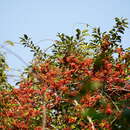Description
(
英語
)
由eFloras提供
Shrubs or trees, evergreen, to 20 m tall; trunk to 1 m d.b.h.; bark gray to gray-black. Young branchlets longitudinally angular, glabrous, rarely puberulent; older branchlets terete, straight, rough, longitudinally fissured, with slightly raised obovate or deltoid leaf scars, lenticels inconspicuous; terminal buds conical, small. Stipules subulate-lanceolate, 1-1.5 mm, caducous; petiole 8-18 mm, glabrous, rarely slightly puberulent, narrowly sulcate adaxially; leaf blade ovate, obovate, or elliptic, 4-9 × 1.8-4 cm, thinly leathery or papery, both surfaces glabrous, midvein impressed adaxially, lateral veins 6-9 pairs, evident on both surfaces, anastomosing near margin, reticulate veins obscure, base obtuse or cuneate, margin entire, slightly recurved, apex shortly acuminate. Inflorescences: cymes of order (2 or)3 or 4, (2-)4-13-flowered, umbelliform, solitary, axillary on current year’s branchlets. Male inflorescences: peduncles 3-11 mm, glabrous; pedicels 3-5 mm, glabrous or puberulent; bracteoles 1 or 2, or absent, basal, ovate-deltoid; flowers white, 4-merous; calyx patelliform, ca. 2 mm in diam., puberulent, shallowly 4-lobed, lobes broadly ovate-deltoid, glabrous, not ciliate; corolla rotate, ca. 5 mm in diam., petals reflexed at anthesis, oblong, ca. 2.5 × 1.5 mm, basally slightly connate; stamens longer than petals, anthers ovoid-ellipsoidal; rudimentary ovary pulvinate, rostellate, apex 5- or 6-lobed. Female inflorescences: cymes of order 2 or 3, 3-7-flowered; peduncles 5-13 mm, glabrous; pedicels (3-)4-8 mm, glabrous or puberulent; flowers white, 5(-7)-merous; calyx shallowly cup-shaped, ca. 2 mm in diam., glabrous, shallowly 5-lobed, lobes deltoid, margin erose; corolla rotate, ca. 4 mm in diam., petals obovate-oblong, ca. 2 mm, basally slightly connate; staminodes ca. 1/2 as long as petals, sterile anthers ovoid; ovary ovoid, ca. 1.5 mm, stigma capitate. Fruit red, subglobose, rarely ellipsoid, 4-6 mm in diam.; persistent calyx explanate, ca. 3 mm in diam., shallow lobes deltoid, not ciliate; persistent stigma thickly discoid, convex, shallowly 5- or 6-lobed; pyrenes 5-7, ellipsoidal, ca. 5 mm, ca. 2.5 mm in diam., abaxially 3-striate and 2-sulcate, rarely 2-striate and 1-sulcate, laterally smooth, endocarp subwoody. Fl. Apr-Jun, fr. Aug-Dec.
- 許可
- cc-by-nc-sa-3.0
- 版權
- Missouri Botanical Garden, 4344 Shaw Boulevard, St. Louis, MO, 63110 USA
Distribution
(
英語
)
由eFloras提供
Anhui (Sixian), Fujian, Guangdong, Guangxi, Guizhou, Hainan, Hubei, Hunan, Jiangsu, Jiangxi, Taiwan, Yunnan, Zhejiang [Japan, Korea, Vietnam].
- 許可
- cc-by-nc-sa-3.0
- 版權
- Missouri Botanical Garden, 4344 Shaw Boulevard, St. Louis, MO, 63110 USA
Habitat
(
英語
)
由eFloras提供
Evergreen broad-leaved forests, forest margins on mountain slopes; 400-1100(-1700) m.
- 許可
- cc-by-nc-sa-3.0
- 版權
- Missouri Botanical Garden, 4344 Shaw Boulevard, St. Louis, MO, 63110 USA
Synonym
(
英語
)
由eFloras提供
Ilex koshunensis Yamamoto; I. microcarpa Lindley & Paxton; I. rotunda var. microcarpa (Lindley & Paxton) S. Y. Hu; ?I. rotunda var. sinensis Masamune; I. sasakii Yamamoto; I. unicanaliculata C. J. Tseng.
- 許可
- cc-by-nc-sa-3.0
- 版權
- Missouri Botanical Garden, 4344 Shaw Boulevard, St. Louis, MO, 63110 USA
Ilex rotunda: Brief Summary
(
英語
)
由wikipedia EN提供
Ilex rotunda, commonly called the Kurogane holly, is an evergreen tree in the holly family (Aquifoliaceae). It is native to east Asia, where it is found in China, Japan, Korea, Taiwan, and Vietnam. Its natural habitat is in evergreen broadleaf forests, often in sunny areas such forest edges or on mountain slopes.
It has spineless leathery leaves and clusters of bright-red berries. It reaches 18 m at maturity (although 20 m is also reported). The tree blooms from May to June, and the seeds become ripe from October to December. The plants are dioecious. The fruits contain flavonols.
Kurogane holly was first described in 1784 by Carl Peter Thunberg, from species growing in Japan.
In Japan, it is commonly planted garden and street tree. It was first introduced to gardens of the New World through collections sent by Robert Fortune. In Japan, kurogane holly is one of the hibakujumoku trees. It is also the official tree of several Japanese municipalities.

Mature flowers


